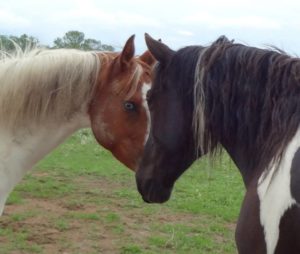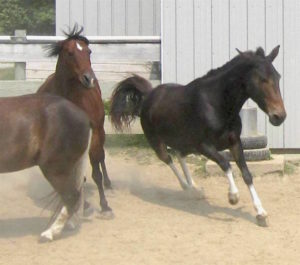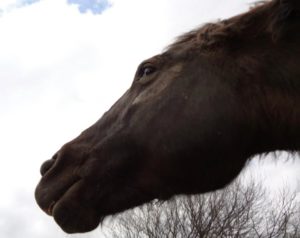When it comes to working with horses, our very humanness can get us in trouble.
Take our use of language: Do you consider “negative” to be bad and “positive” to be good?
When working with horses, the opposite is often true.
I’m talking about negative and positive reinforcement, two avenues of learning that stem from operant conditioning, an umbrella theory popularized by B. F. Skinner. The American researcher was preceded by the Russian physiologist, Ivan Pavlov, and others. To learn more about operant conditioning, classical conditioning, and the origins thereof, watch this short, helpful video.
Briefly, negative reinforcement is applying a negative stimulus until the subject acts or moves in the requested manner. Then, the stimulus is removed. “Pressure and release” is an example of negative reinforcement.
Positive reinforcement is rewarding a subject when it acts or moves in the requested manner. Clicker training and training with  treats are examples of positive reinforcement. Watch this interpretation of it on the Big Bang Theory here.
treats are examples of positive reinforcement. Watch this interpretation of it on the Big Bang Theory here.
Why is negative reinforcement appropriate and positive reinforcement less so?
Watch horses with horses. Watch almost any prey animal with any predator. In both instances, negative reinforcement is what you see.
Horses understand negative reinforcement and they understand the related idea of increased pressure, which Ray Hunt described as: “Be as soft as possible and as firm as necessary.”
Example: You’re a new horse in a herd. You approach the alpha mare. She pins her ears. You don’t move away. She pins her ears, purses her muzzle, and turns her head to you. You still don’t move. She spins and double barrels you. You move away and the alpha mare takes away the pressure.
The beauty of negative reinforcement is that the stimulus gets smaller and smaller as the horse learns what is being asked. The alpha mare will likely not need to double barrel the new horse again. A good ear pinning will yield a sufficient response. The new horse understands what comes after an ear pinning and will act to avoid that event.
It should be noted that many horse folks never see indications of negative reinforcement (between horses or between horse and  rider) until it becomes glaringly obvious.
rider) until it becomes glaringly obvious.
“When it comes to negative reinforcement, there’s escape and avoidance,” said clinician Warwick Schiller. “Horses use mostly avoidance, but most people see only escape.”
Tiny shifts in leg, seat, and hand position can all be quickly and accurately interpreted by the horse as pressures. When the horse quietly and willingly reacts, it feels release.
“Negative” is not bad or cruel or mean here. It’s natural.
Here’s another red flag on being human: We tend to think in linear terms. Schools of thoughts and training models are all linear concepts. You do A and your result will be B.
But horse work is more like weather. It’s not linear or necessarily predictable. It relies on the ability to be in the moment, to adjust to different conditions and different horses, and to be able to think outside any scholarly box.
Read about Learning Theory liabilities.
WiseAssWallace will have something to say about these ideas soon.

Great food for thought. I appreciate these kinds of articles.
Keep up the good work.
Laurie
ALL animals have to LEARN about negative or positive reinforcement as well as punishment. They aren’t born knowing about these things. They have to learn about them. This is how all animals learn to “operate” on their environment to get what they want. Study up on learning science.
Besides which, we aren’t horses and the horses know that.
Thanks for your comment, Laurie. Social learning has been criticized on many fronts — but the first that comes to mind is the fact that Bandura et al focused on human’s very social, verbal, and frontal lobe world.
RE: Watch horses with horses. Watch almost any prey animal with any predator. In both instances, negative reinforcement is what you see.
Comment: Watch a little more closely and you will notice when negative reinforcement is used between horses, the option of fight or flight is always open and available.
With human confinement, neither of those options are available. They will get snubbed up, tied up, whipped or whatever it takes to prevent fight or flight. The only thing left under those circumstances is freeze which is too often referred to as submission or even trained. It is neither. It is shut down PTSD.
If one wants to behave like a horse during negative reinforcement, the horse in question must be left with the choices of fight or flight. If nether of those are acceptable, then one must switch to either some positive form of communication or tie them up and flood the hell out of them.